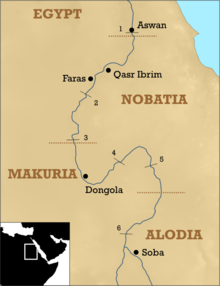Soba (city)


Soba is an archaeological site and former town in what is now central
In the 10th century
Archaeological research
In its heyday, the city covered approximately 275 hectares, but the excavations carried out prior to 2019 only encompassed about 1% of this area.
In 2019, the interdisciplinary project “Soba – the heart of Alwa” was commenced. It is carried out by the Polish Centre of Mediterranean Archaeology University of Warsaw and the Institute of Archaeology and Ethnology of the Polish Academy of Sciences and is directed by Mariusz Drzewiecki (PCMA UW).[1] It aims to study the topography of Soba and determine the extent, spatial structure, and character of each city quarter.[3] A magnetic geophysical prospection revealed unknown parts of medieval Soba.[5] In one of the quarters, large architectural complexes stood at a distance from each other; in another, a clear street grid is visible.[1] Test trenches were also excavated in strategic spots in the city or in places where the results of the geophysical research are not unequivocal.[6] The residence of the kingdom of Alwa’s rulers has not yet been identified.[1]
Notes
- ^ a b c d "Soba". pcma.uw.edu.pl. Retrieved 2020-07-28.
- OCLC 1070966107.
- ^ a b "Soba – a new research project in Sudan". pcma.uw.edu.pl. Retrieved 2020-07-28.
- ISSN 1555-8622.
- S2CID 239622640.
- ^ Mariusz Drzewiecki, Robert Ryndziewicz, Tomasz Michalik, Joanna Ciesielska, Ewa Czyżewska-Zalewska, Maciej Kurcz, Mokhtar Maali Alden Mokhtar Hassan, Soba Expedition. Preliminary report on the season of fieldwork conducted in 2019–2020, report written for the National Corporation for Antiquities and Museums of Sudan.
Further reading
- Adams, William Y. (1977). Nubia: Corridor to Africa. Princeton: Princeton University Press. ISBN 0-7139-0579-4.
- Drzewiecki, Mariusz; Michalik, Tomasz (2021). "The beginnings of the Alwan capital of Soba in light of new archaeological evidence". Polish Archaeology in the Mediterranean. 30/2 (30/2). University of Warsaw: 419–438. S2CID 247652880.
- Drzewiecki, Mariusz; Ryndziewicz, R. (2019). Developing a New Approach to Research at Soba, the Capital of the Medieval Kingdom of Alwa. Archaeologies,15.
- Drzewiecki, M., Ryndziewicz, R., Ciesielska J.A., Michalik, T., Kurcz M., Czyżewska-Zalewska E., Adam, R. J. (2020). New fieldwork at Soba East (2019–2020 season), Sudan & Nubia 24, 233–246.
- Drzewiecki, M., Kurcz, M., Ciesielska, J. Michalik T., Czyżewska-Zalewska E., Kiersnowski, K., Ryndziewicz R. (2021). Interdisciplinary Research into the Legacy of the Medieval Metropolis of Soba in a Modern Khartoum Suburb, African Archaeology Revue, 38, 597–623. DOI: 10.1007/s10437-021-09459-1
- Drzewiecki, M., Ryndziewicz, R., Ciesielska, J., Kurcz, M., Michalik, T., & Czyżewska-Zalewska, E. (2022). The spatial organisation of Soba: A medieval capital on the Blue Nile. Antiquity, 96(385) 213-220. DOI: 10.15184/aqy.2021.158
- Shinnie, P. (1961). Excavations at Soba. Sudan Antiquities Service. OCLC 934919402.
- Welsby, Derek (1998). Soba II. Renewed excavations within the metropolis of the Kingdom of Alwa in Central Sudan. ISBN 978-0-7141-1903-8.
- Welsby, Derek (2002). The Medieval Kingdoms of Nubia. Pagans, Christians and Muslims Along the Middle Nile. British Museum. ISBN 978-0-7141-1947-2.
- Welsby, Derek; Daniels, C.M. (1991). Soba. Archaeological Research at a Medieval Capital on the Blue Nile. The ISBN 978-1-872566-02-3.
External links
15°31′26″N 32°40′51″E / 15.52389°N 32.68083°E
- Soba – the heart of Alwa – the website of the research project
